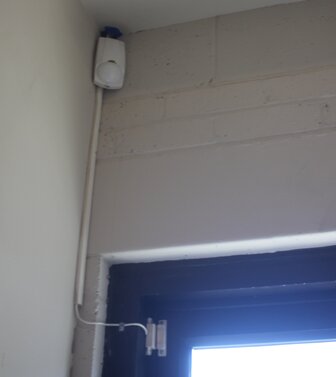Video MGMT System
 Access Control
Access Control
Voice & Data Wiring
 Burglar Alarm
Burglar Alarm
 Fire Alarm
Fire Alarm
Video MGMT System
Voice & Data Wiring
By detecting movement and triggering appropriate actions, commercial motion sensors make buildings and public spaces safer and more comfortable for everyone.
Occupancy motion sensors detect people or objects and are commonly used to trigger lighting, HVAC, and alarm systems.
There are several types of occupancy sensors, including passive infrared (PIR) sensors, ultrasonic sensors, and microwave sensors.
Active sensors are called "active" because they emit signals, such as microwaves or ultrasonic waves, into the atmosphere. An active sensor detects motion by recognizing changes in the reflection patterns of the signals they emit.
Ultrasonic motion sensors are a type of active motion sensor. They emit high-frequency sound waves (in a range above human hearing) that bounce off objects in their detection range before returning to the sensor.
By measuring the time it takes sound waves to bounce back from objects, ultrasonic motion sensors are able to recognize movement. And because they emit sound waves at a wide range of angles, they're great at detecting motion in three dimensions.
Aside from security alarm installations, ultrasonic sensors are commonly used to detect approaching bodies for automatic doors and parking lot gates.
Microwave sensors generate microwave pulses, which is why they're considered active sensors. They emit a continuous stream of microwave radiation, usually in the range of 1 to 10 GHz, that bounces off objects before returning to the sensor. These sensors recognize movement by measuring the frequency and phase of their reflected pulses.
The greatest strength of microwave sensors is their ability to detect movement through solid objects, such as walls and doors. This ability makes them especially useful for monitoring where line-of-sight is obstructed.
Microwave motion detectors are often used in automatic doors and motion-activated burglar alarm systems.

Unlike ultrasonic and microwave motion sensors, passive infrared (PIR) sensors don't emit any energy. Instead, they detect movement with a pyroelectric sensor that senses changes in the infrared radiation naturally emitted by living beings and objects warmer than absolute zero.
Passive infrared sensors are especially good at detecting human and animal movement because living bodies emit a lot of infrared radiation.
When a person or object moves in the range of a passive infrared sensor, the amount of infrared radiation in the area changes, causing the PIR sensor to trigger an alarm or other response.
Passive infrared sensors are commonly used to detect intruders and to support automated lighting systems.
There are several types of proximity sensors, including inductive, capacitive, and photoelectric sensors. Inductive sensors detect metallic objects, capacitive sensors detect non-metallic objects, and photoelectric sensors use light to detect objects.
What all proximity sensors have in common is the ability to recognize movement by emitting signals that are either reflected or absorbed by objects in their range. They're particularly reliable because they aren't affected by factors like temperature or humidity.
Proximity sensors have many uses—ranging from detection of objects on manufacturing lines to detection of hands near touchscreen displays to motion detection for burglar alarms and other security system components.
A tomographic sensor emits electromagnetic radiation to create 3D images. These sensors are commonly used to capture X-rays in medical contexts and for baggage and body surveillance at airports.
The amount of radiation emitted by these sensors is usually low and considered safe when used in moderation.
The greatest advantage of tomographic sensors is that they can create detailed and accurate 3D maps of areas being monitored.
A dual sensor works by integrating two separate sensors, such as a PIR sensor and a microwave sensor, into a single device. By combining motion sensor technologies, a dual sensor has fewer false alarms caused by environmental factors and interference.
For example, a PIR sensor may be triggered by a sudden change in temperature, while a microwave sensor may be triggered by movement outside of its range. By requiring both types of sensors to be triggered, dual devices have fewer false alarms.
It's worth noting that motion detectors are rarely foolproof. PIR sensors can be triggered by sunlight or heating vents. Microwave motion sensors can create false alarms when affected by temperature changes and sources of electromagnetic radiation. And ultrasonic motion detectors can be affected by wind, temperature changes, and certain types of soft or porous materials, which can absorb or scatter sound waves and result in false alarms.
Careful placement and configuration can minimize the likelihood of false alarms. For example, our team at Mammoth Security knows to install sensors away from heat sources when possible—and how to position them to reduce false alarms when installation near heat can't be avoided.
In addition to expert installation, the application of dual sensors is an excellent solution to the problem of false alarms. By combining sensors, dual systems can avoid the confusion that sudden changes in temperature and other environmental factors can cause to individual sensors.

Our team here at Mammoth Security knows how to place, configure, and combine motion sensors for the most accurate readings with the fewest false alarms.
If you're ready to take the next step toward a professional security installation that will protect your commercial property from a wide range of threats, fill out the simple form below. We'll quickly reach out to schedule your free, zero-obligation site survey and security assessment with a friendly expert from our team.
NOT COMPLETELY SURE?
860-748-4292Passive infrared (PIR) sensors are the most common type of motion sensor for businesses. Motion sensors work by detecting the heat emitted by moving objects, such as humans, animals, and cars. Passive infrared sensors are widely used in automatic lighting, occupancy detection, and security alarm systems.
The terms "motion sensor" and "motion detector" are often used interchangeably, but there is a subtle difference between the two.
A motion detector is a type of sensor that works by detecting changes in heat or motion using infrared, ultrasonic, or microwave technology. On the other hand, a motion sensor is a more general term that can refer to any type of sensor that detects movement. This could include motion detectors, as well as other types of sensors that use different technologies, such as optical or magnetic sensors.